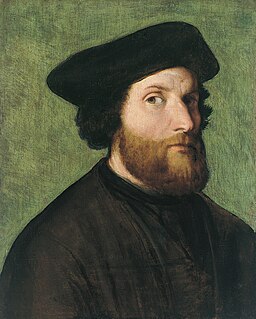
Lorenzo Lotto was an Italian painter, draughtsman, and illustrator, traditionally placed in the Venetian school, though much of his career was spent in other north Italian cities. He painted mainly altarpieces, religious subjects and portraits. He was active during the High Renaissance and the first half of the Mannerist period, but his work maintained a generally similar High Renaissance style throughout his career, although his nervous and eccentric posings and distortions represented a transitional stage to the Florentine and Roman Mannerists.

Giovanni Battista Castello was an Italian historical painter.
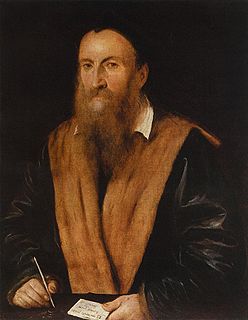
Girolamo Romani (Romanino) was an Italian High Renaissance painter active in the Veneto and Lombardy, near Brescia. His long career brought forth several different styles.

Marcantonio Franceschini was an Italian painter of the Baroque period, active mostly in his native Bologna. He was the father and teacher of Giacomo Franceschini.

Sebastiano Ricci was an Italian painter of the late Baroque school of Venice. About the same age as Piazzetta, and an elder contemporary of Tiepolo, he represents a late version of the vigorous and luminous Cortonesque style of grand manner fresco painting.
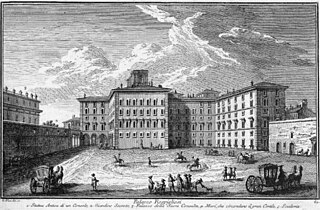
The Palazzo Pallavicini-Rospigliosi is a palace in Rome, Italy. It was built by the Borghese family on the Quirinal Hill; its footprint occupies the site where the ruins of the baths of Constantine stood, whose remains still are part of the basement of the main building, the Casino dell'Aurora. Its first inhabitant was the famed art collector Cardinal Scipione Borghese, the nephew of Pope Paul V, who wanted to be housed near the large papal Palazzo Quirinale. The palace and garden of the Pallavicini-Rospigliosi were the product of the accumulated sites and were designed by Giovanni Vasanzio and Carlo Maderno in 1611–16. Scipione owned this site for less than a decade, 1610–16, and commissioned the construction and decoration of the casino and pergolata, facing the garden of Montecavallo. The Roman palace of this name should not be mistaken for the panoramic Villa Pallavicino on the shores of Lake Como in Lombardy.

St. Stephen's Cathedral is a baroque church from 1688 in Passau, Germany, dedicated to Saint Stephen. It is the seat of the Catholic Bishop of Passau and the main church of his diocese.

Bissone is a municipality in the district of Lugano, in the canton of Ticino in Switzerland.

The Kroměříž Castle is a castle in Kroměříž in the Czech Republic. It used to be the principal residence of the bishops and archbishops of Olomouc. UNESCO listed the gardens and castle as a World Heritage Site in 1998 because of its exceptionally well-preserved and outstanding Baroque gardens.
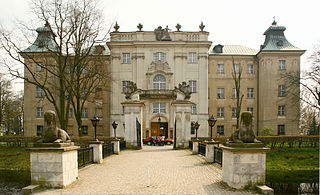
The Rydzyna Castle is a Baroque castle in Rydzyna, Poland. It was built in the beginning of the 15th century by Jan of Czernina. At the end of the 17th century, Italian architects Joseph Simon Bellotti and Pompeo Ferrari erected the present Baroque castle on its ancient foundations. The first owners of the castle were the Leszczyński family. Together with a park and surrounding areas, it was one of the most splendid palaces in Great Poland.

The Dominican Church, also known as the Church of St. Maria Rotunda, is an early Baroque parish church and minor basilica in the historic center of Vienna, Austria. It is the third church built on the same site in the course of time.

Andrea Celesti (1637–1712) was an Italian painter of the Baroque period, working in Venice. His style gravitated over the years from a turgid and academic weightiness to a lighter, looser brushstroke.
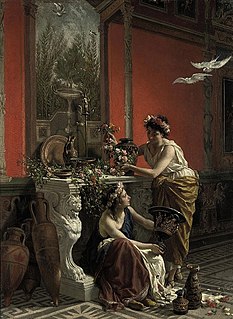
Cesare Mariani was an Italian painter and architect of the late-19th century, active in Rome and Ascoli Piceno.

Giovanni Giacomo Barbelli was an Italian painter of the Baroque period, active in Lombardy. He was a canvas and fresco painter known for his religious and mythological scenes that decorate many churches and residences in Lombardy. He was a highly skilled draughtsman and a brilliant colorist. His work shows an inventive imagination and a thorough knowledge of perspective.

Carlo Antonio Bussi was a Swiss painter. Bussi was born in Bissone. He primarily painted church interiors. In 1682 he married Margarete, the daughter of another Swiss painter Carpoforo Tencalla. After his father-in-law's death in 1685, Bussi completed some of Tencalla's projects. Bussi died in Vöcklabruck in 1690.
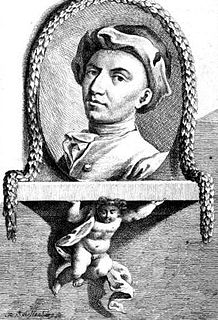
Luca Antonio Colomba (1674–1737) was a Swiss Baroque painter born at Arogno. His style was distinguished for its happy compositions and its careful design, as also for the delicate and tender colours. He painted in oil and fresco.

The House of Attems is the name of an ancient and illustrious Friulian parliamentary family that held the titles of princes, counts and barons. The family, from the native castle of Attimis, branched off into Italy and Austria in different lineages, each named after different fiefdoms and domains held. It seems certain that the founder of it is Enrico, already Marquis of Tuscany, who in February 1170 was appointed with his brother Arpone among the deacons of the patriarch of Aquileia Woldarico and from this, in the same year, was conferred the castle of Attems or Attimis. The main lines of this family are those of the Attems of the Trident, that branched in the Attems of Cividale (extinct); the Attems of Udine; the Attems of S. Croce; and the Attems Petzenstein, and that of the Attems of the Bear (Extinct).

The Palazzo Barbarigo Minotto is a 15th-century palace on the Grand Canal in Venice, northern Italy, next to the much larger Palazzo Corner. Built in the Venetian Gothic style, it was originally two palaces, Palazzo Barbarigo and Palazzo Minotto, later joined together. The Barbarigo palace was owned by the Barbarigo family for several centuries and was the birthplace of Gregorio Barbarigo, who once refused the Papal Crown. It was later owned by the Minotto and Martinengo families.

Grazioso Rusca was a Swiss sculptor who was also active in northern Italy.

Matteo Castelli was a Swiss architect. His nephew Costante Tencalla also became an architect.




















